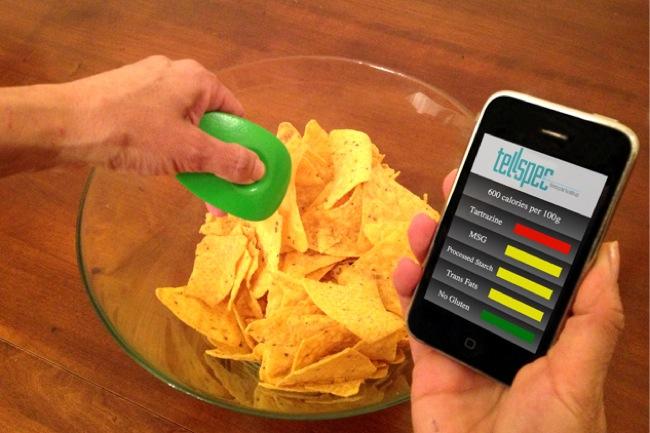
Do you really know what’s in that three-item combo platter that you just ordered at your local takeout? Sure, there’s probably what looks like a taco, an enchilada, and a burrito, but chances are you have no clue what the food is actually made up of – and, as long as it’s tasty, you probably don’t care. Here’s why you might want to reconsider what you shove into your mouth: foods have lots of chemicals and allergens, and, if you’re eating out, it’s difficult to determine the nutritional info and ingredients just by looking at what’s on your plate. It is especially important if you have strict dietary restrictions or serious allergies, or you’re simply trying to watch what you eat – even if you’re cooking your own food or there’s a nutrition label. But, with a little help from a magical device called the TellSpec, you can get all the food info beamed to your smartphone just by waving it over your grub.
That magic wand is technically a spectrometer scanner. With a custom algorithm and a companion app on your smartphone, the TellSpec can determine the allergens, chemicals, nutrients, calories, and ingredients in the food. Here’s how it works: According to TellSpec, “Light is made up of particles called photons. When you beam the low-powered laser in the TellSpec scanner at the food, some of the photons are absorbed, raising the energy states of the molecules in the food. Lower energy photons are then reflected back. The spectrometer inside the TellSpec scanner sorts these photons by wavelength and counts them. The resulting numbers, called a spectrum, describe the chemical compounds in the food.” The spectrum is sent to an “analysis engine” in the cloud via your phone (through Bluetooth), and all the aforementioned nutritional info is then sent back to your phone.

The TellSpec can scan foods directly or through plastic or glass, which means you can determine if that cake behind the bakery window is safe to eat or not. Besides identifying the makeup of your food, the TellSpec app can warn you about allergens like gluten or egg; help you achieve calorie targets; clarifying inaccurately reported food labels; and monitor what you eat, as well as your intake of essential vitamins and minearals.
TellSpec is currently in the prototype stage. The picture of the device shown is a non-working 3D model of what the scanner could eventually look like. They have successfully tested three different types of scanners. Work continues, but they are reaching out to the public for funding via Indiegogo to help them manufacture the device, get regulatory approvals, and develop the software development kit for Android and iOS. For TellSpec, the challenge is to create a spectrometer that’s compact enough to fit on your keychain. They have already exceeded their $100,000 goal, and sold out of the $150 early bird special. However, estimated delivery of the product won’t be until August 2014. This product could help millions of people, so let’s hope it doesn’t end up becoming vaporware.


